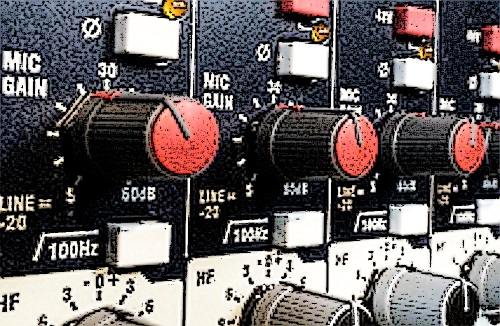When it comes to live sound, input gain is one of those things you have to get right. If your gain structure is wrong, no amount of EQ, compression or fancy plugins will fix it.
Over the years, I’ve seen my share of gain disasters, and have found many who simply don’t know how to properly gain stage their console.
I’m going to offer you two ways to set up your gain, plus a hybrid approach (the .5). There a few schools of thought on how to set gain, and it’s hard to say that one is “right;” it really depends on many factors. There are some wrong ways to do it, however, and we’ll get to those in a moment. First, let’s define input gain.
Input gain is the gain applied by the console to mic and line level inputs coming into the each channel. Most consoles have a gain knob at the top of the channel strip labeled “Gain,” “Input Level,” or sometimes confusingly, “Trim.”

The knob controls how much gain is applied to the microphone preamp, which is necessary to bring the level up from the lower mic level to the working level inside the console. Things are a little different for line-level inputs, and for clarity’s sake, we’ll focus on mic inputs for now.
How Not To Set Gain
Running your input gain way too high will generally result in distortion. There are a few consoles—typically expensive analog ones—that will handle overdriven mic preamps with grace, and even sound good. But generally, you want to avoid lighting up the peak, overload or clipping lights. This is especially true with digital consoles.
You can usually tell the input gain is set too high on your console if you find yourself running all your faders below −20, and the master is also turned way down. It will also sound bad. That should be the first clue, in fact.
Conversely, you can also run the input gain too low with adverse effects. When the input gain is too low, your channel faders will all be pushed way up, the master will be all the way up and there will be plenty of noise in the system even when there is nothing playing. If you are also mixing monitors or using personal mixers with your desk, they will be very noisy as well.
Proper Gain Structure Makes Life Better
Clearly, there needs to be some kind of happy medium here. We need to find the proper amount of gain to apply to each channel that will be the best compromise between headroom, sound quality and ease of mixing.
The two most common schools of thought are separated by the question of what to do with the faders. The first way to approach gain is to set the faders at unity, then dial each channel’s gain up to an appropriate level for a good starting house mix. The second way is to maximize the gain of each channel, bringing each mic preamp up to optimal operating level, regardless of relative volume in the house.
There are good reasons for each method, and often times, they are not that far apart when it comes to actual implementation. But as we all know, live sound is about compromise, and we have to determine what the best compromise is for our settings.
For simplicity, let’s call the two schools “Faders at Unity” and “Maximized Preamp Gain.”




















